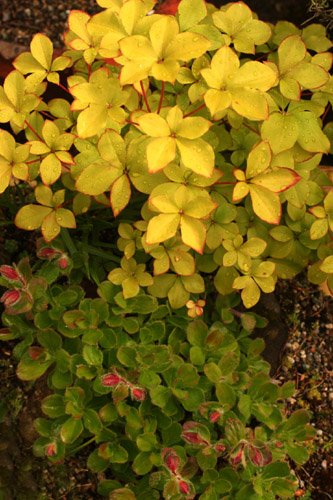|
|
|
|
|
|
|
When not in flower this unique little Rhododendron might
easily be
mistaken for a dwarf species of arctic willow, especially since
it
hardly
attains a height of 10-15 cm. Nevertheless, being
gently
stoloniferous,
it is capable in time of creeping or suckering over
a considerable area given optimum conditions.
|
|
It is
completely
deciduous
and when the leaves eventually appear they are
conspicuously
setose (i.e. possessing small hairs) particularly on their
margins. Towards the end of September and throughout Autumn
the
leaves take on beautiful shades of russet and gold so that
the
plant
is worth growing simply for its late foliage.
|
|
|
|
|
| The flowers
suddenly
appear in May/June and are quite large when considering
the
diminutive nature of the the plant. They are held aloft on
erect
pedicels,
presumably to attract pollinating insects and to receive
every possible glimmer of sunlight during the short summer. |
|
| R.
camtschaticum is distributed along the Pacific seaboard from
Japan
to Alaska, also occurring on Sakhalin Island, the Kuril
Archipelago
and the Kamchatka Peninsula itself. It is essentially
a
tundra component, associating with dwarf species of Salix,
Vaccinium,
Phyllodoce, Dryas and Diapensia, together with many
Mosses
and Lichens.
|
|
|
|
|
|
| In cultivation it produces copious amounts of
seed
which matures very quickly in comparison with other members
of
the genus. It is said that the seed does not germinate very
readily
although
I have yet to test it. |
| I have the plant growing in a sink
along
with
other young Rhododendrons but I suspect that within a year
or
two
it will completely dominate the other plants in the sink and
will
have to be moved on into open ground. I am already attempting
to propagate its 'stolons'. Despite the fact that every
available image
of
R. camtschaticum growing in its native habitat invariably
contains
plenty of snow, the Pacific influence also brings
insulating mists,
moist
winds, and very few late frosts. In other words the species
should
feel at home in our part of the world. |
| After all, Kamchataka
is
approximately at the same latitude as Northern Ireland, it's
just
that
the ocean has a different name!
|
|
 |
|
R. c. with R. quinquefolium
(above) |
|
|
|
|
| Incidentally,
in putting this short account together, I have become
much more closely acquainted with the flora and fauna of the
Kamchatka
Peninsula, not to mention its 26 active volcanoes. Maybe
one
day the more intrepid members of the Ulster Group will
venture
into this forbidding but beautiful land, braving both its
mosquitoes and
its bears, in order to explore its botanical bounty.
|
|
Rhododendron
camtschaticum: by John Weagle
www.rhododendron.no
|
| The
Illustrated Rhododendron : Pat Halliday p.252
Timber Press 2001
|
|
|
|
|
|
|
|
|
|
|
|
|
|
|
|
